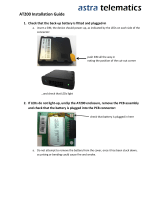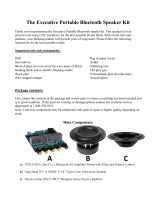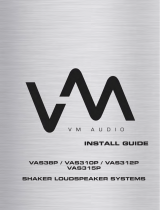
Speaker System
WS-AT200
Subwoofer System
WS-AT250
Before attempting to connect or operate this product, please read these instructions completely
CONTENTS
REGULATORY STATEMENTS ............................................................................ 2
SAFETY INSTRUCTIONS .................................................................................... 2
PREFACE ............................................................................................................ 3
PRECAUTIONS ................................................................................................... 3
INSTALLING THE SPEAKER .............................................................................. 4
CONNECTING SPEAKER CABLES .................................................................... 6
WIRING CONNECTOR AND CABLE .................................................................. 7
SETTING THE SUBWOOFER PROCESSOR ....................................................... 8
PROTECTION CIRCUITS FOR WS-AT200 .......................................................... 8
SYSTEM DIAGRAM ............................................................................................ 8
BLOCK DIAGRAM .............................................................................................. 9
SPECIFICATIONS ............................................................................................... 9
TYPICAL PERFORMANCE .................................................................................. 10
DIRECTIVITY ....................................................................................................... 10
APPEARANCE .................................................................................................... 11
WS-AT200
WS-AT250

-2-
Please observe the following instructions carefully for your own safety and that of equipment.
• If the speakers fall, it can cause serious damage to persons or properties.
• Read the instructions printed on the back of the speakers.
• Ask your nearest dealer or qualified installers for installation and wiring.
• Place the speakers on a stable surface.
• Secure the speakers with safety wires or equivalent.
• Detach the speaker and the speaker stand before adjusting their height.
• Separate the speaker and the speaker stand before moving the set to a different location.
• Do not install the speaker with the stand at a place where passers-by might stumble on them.
SAFETY INSTRUCTIONS
WARNING:
TO PREVENT FIRE OR ELECTRIC SHOCK HAZARD,
DO NOT EXPOSE THIS APPLIANCE TO RAIN OR
MOIS
TURE.
The serial number of this product may be found on the back
of the unit.
You should note the serial number of this unit in the space
provided and retain this book as a permanent record of your
purchase to aid identification in the event of theft.
Model No.
Serial No.
REGULATORY STATEMENTS

-3-
WS-AT200
• This speaker system is a 2-way bass-reflex type
incorporating a 30-cm (12”) woofer and a Square
Contour Wave Guide (SCWG) horn tweeter.
• The speaker system accepts a continuous program
input of 300 W or 150 W (RMS). It delivers high out-
puts from its compact body with a maximum sound
pressure level of 121 dB.
• The SCWG horn minimizes the disturbing reflection
sound generated near the open end and to provide
a constant directivity of 90˚ (horizontal) and 40˚
(vertical). You can easily attach again the horn to
the enclosure by turning it 90˚ as required for hori-
zontal or vertical speaker installation.
• The enclosure has essential features such as
toughness to transportation, a recessed type han-
dle for carrying, the convex and concave for stack-
ing, holes for mounting bracket, safety wires, etc.
PREFACE
WS-AT250
• This Subwoofer is a bass-reflex type incorporating a
20-cm (12”) cone speaker and to be used with the
RAMSA Subwoofer Processor WS-SP2A.
• The WS-AT250 accepts an input of 400 W (RMS). It
delivers high outputs, though it is small in size, with
a maximum sound pressure level of 117 dB.
• The enclosure has essential features such as
toughness to transportation, a recessed type han-
dle for carrying, the convex and concave for stack-
ing, holes for mounting bracket, safety wires, etc.
PRECAUTIONS
* High frequency noise developed by fast-forward
or fast-rewind operation of a tapedeck
* Out of tune noise in FM broadcast
* Feed-back from microphones or electronics
musical instruments
• Match the polarities of all the speakers by observing
the connectors and wire colours when using two or
more speakers.
• Read “PROTECTION CIRCUITS” on page 8. Turn
down the volume control of the amplifier immediate-
ly if the sound suddenly decreases.
• You should use the WS-AT250 Subwoofer all the
time with Subwoofer Processor WS-SP2A. The WS-
SP2A processes the signal to protect the speakers
from damage due to an excessive input signal.
• Power loss may increase as the total speaker
impedance gets lower with a number of speaker
hookups. Use the largest speaker cable in wire
gauge to reduce power loss.
• Switch off the power amplifiers before connecting
the speakers or other peripherals.
• Avoid the followings all the time to protect the
speakers from damage.
* Turning on and off mixing consoles and other
peripherals may cause shock noise when the
amplifiers and subwoofer processor are on
* Shock noise resulting from the connection/ dis-
connection of inputs/outputs with any powered-
up equipment
* Pop noise from microphones without appropri-
ate use of breath-pop screen and/or high-pass
filter
* Click noise caused by switching on or off the
phantom power for microphones
* Continuous operation at very low frequency from
an oscillator, synthesizer or program sources.

-4-
• Changing the tweeter direction
You can alter the directivity when placing the WS-
AT200 horizontally.
1. Unscrew four bolts to detach the tweeter.
2. Turn the tweeter by 90˚.
3. Tighten four bolts to attach the tweeter again.
4. Rotate the RAMSA badge by 90˚.
INSTALLING THE SPEAKER
• Stacking
Speakers can be stacked one upon another as illustrat-
ed.
Place an additional speaker on top of another, making
sure to match their convex and concave portions.
Do not place stacked speakers on an unstable surface.
If the surface is uneven, not level, or vibrating, the
stacked speakers may fall down and cause injuries.
40
90
40
90
Sound dispersion angles

-5-
• On wall or ceiling
You can install the speaker on a wall or ceiling with a
mounting bracket (not supplied).
q Place the bracket on the enclosure.
w Screw the eye bolts into the screw holes of the
enclosure by hand.
e Fix the speaker to a wall or ceiling.
r Take safety protections mentioned in “Secure the
speaker.”
Note: Installers should seek advice on the building
structure and load capacity, if unknown, from
an architect or a structural engineer.
• Secure the Speaker
Use safety wires (not supplied) when hanging the
speaker from a wall or ceiling. This is not a major
means of support but just a safety relief.
q Tighten the eye bolts with washers and bolt nuts
(not supplied) into the screw holes of the enclosure
by hand.
w Set the direction of the eye bolts to be in the best
position for binding safety wires.
e Fasten the bolt nuts with wrench.
r Bind one end of safety wires to the eye bolts.
t Secure the other end of safety wires to the support-
ing structure of the building.
• Mounting on a stand
1. You can mount the speaker on a speaker stand by
using the stand hole in the enclosure bottom.
2. The stand should have a supporting pipe of ø1.5
inches.
3. Take safety protections by placing it in a safety
location, for exemple.
INSTALLING THE SPEAKER
Eye Bolt
Washer
Set direction
Bolt nut
Tighten with wrench
Hand
tighten
Hand
tighten
Insert
Mounting
bracket
Stand hole
(Bottom side)

-6-
You can find the TS (tip-sleeve) phone jack and
SPEAKON connector on the back of the enclosure.
These two are usable as input or output terminals since
they are wired in parallel. See the block diagram on
page 9.
CONNECTING SPEAKER CABLES
Notes:
• Do not connect more than two speakers in parallel.
Excessively low impedance can cause distorted
output sound or damage to the amplifier.
• Match the sound phase of all speakers by confirm-
ing the polarities of connection when using two or
more speakers.
1. Connect signal input from an amplifier to either TS
phone jack or SPEAKON connector.
2. Bridge the first speaker and the second when using
two speakers in parallel as illustrated.
From
amplifier
From
amplifier
From
amplifier
From
amplifier
SPEAKON connector
TS phone jack

-7-
WIRING CONNECTOR AND CABLE
Cap
Cable clamp
Cable clamp
Loosen screws.
Push
Cable
Tighten the screw.
Solder here.
Push to the end.
Convex
Convex
Concave
Concave
Cap
AMP OUT SPEAKON
+1 +
1 –
(Not used)
2 +
(Not used)
2 –
–
Terminal block
Connector sleeve
Push
Plug Cover
Speaker Cable
Sleeve
Tip
AMP OUT Plug
+ Tip
– Sleeve
TS (tip-sleeve) phone plug
1. Unscrew the plug cover.
2. Thread speaker cables through the plug cover.
3. Connect and solder the + (positive) polarity wire to
the tip of the plug.
4. Connect and solder the – (negative) polarity wire to
the sleeve of the plug.
5. Tighten cable with the clamp of the plug.
6. Fasten the plug cover.
SPEAKON connector
Use SPEAKON connector (4-pole, NL4FC series, by
NEUTRIK AG) as followings.
q Unscrew the connector cap by rotating it counter-
clockwise.
w Slide the cable clamp out from the rear of the con-
nector.
e Push and separate the connector sleeve from the
terminal block.
r Pass the connector cap and cable clamp over the
end of the cable.
t Loosen the clamping screws in the terminal block.
y Prepare and insert the wires into the terminals as
shown in the table.
u Tighten the screws to secure the wires.
i For added security in portable applications, solder-
ing of the wires together with the terminals is recom-
mended.
o Assemble the terminal block and the connector
sleeve after matching the positions of the concave
and the convex.
!0 Match the convex position of the cable clamp to the
concave of the connector sleeve, then push the
cable clamp.
!11 Screw the connector cap.

-8-
SETTING THE SUBWOOFER PROCESSOR
PROTECTION CIRCUITS FOR WS-AT200
SYSTEM DIAGRAM
Audio
Mixer
WS-SP2A
Subwoofer
Processor
In A
In B
Amplifier
Amplifier
Amplifier
150W
150W
400W
BTL
400W
BTL
WS-AT200
WS-AT250
The WS-AT200 has separate overload protection cir-
cuits for woofer and tweeter. When activated by an
excessive input signal, they mute the output sound.
Turn down the volume control for 2 to 20 seconds to
reset the circuits.
A B VLFI VLFI
123 123 123
AK
WS-AT250
SUB WOOFER MAIN SPEAKER
RECOMMENDED FUNCTION SELECTOR SETTING
FUNCTION SELECTOR POSITION
WS-AT200
For further details please refer to the Operating Instructions of the RAMSA Subwoofer Processor WS-SP2A.
Note: Make sure to lower the volume control of the
amplifiers if the output sound suddenly decreases.
Keeping or even increasing the volume can cause
serious damage to the speaker.
This shows an example of system connections.

-9-
WS-AT200 WS-AT250
Type 2 Way, Bass-reflex type Bass–reflex type
Input impedance 8 Ω
Power capacity 300 W (continuous program input) 400W (RMS)
150 W (RMS) —
Sound Pressure Level 99 dB [1 W, 1m (3.3 ft)] 92 dB [1 W, 1m (3.3 ft)]
Max. Sound Pressure Level 121 dB [1m (3.3 ft)] 118 dB [1m (3.3 ft)]
Frequency response 70 Hz - 18 000 Hz 30 Hz - 1 400 Hz
Crossover frequency 2400 Hz —
Speaker
Woofer 30 cm (12”) cone speaker 30 cm (12”) cone speaker
Tweeter SCWG horn speaker —
Dispersion 90° (horizontal), 40° (vertical) —
Dimensions 394 (W) x 577 (H) x300 (D) mm [15-1/2” (W) x 22-3/4” (H) x 11-13/16” (D) ]
Weight 15 kg (33.1 lbs.)
Finish
Enclosure Resin molded, Blue black
Front panel Punched grille, Blue black
Standard accessories Eyebolt (M8 x 25) ........................................... 2
Operating Instructions .................................... 1
BLOCK DIAGRAM
SPECIFICATIONS
!
@
Phone jack
SPEAKON
Connector
Tweeter
Woofer
Tweeter
Protector
Woofer
Protector
HPF
LPF
!
@
Phone jack
SPEAKON
Connector
Woofer
WS-AT200
WS-AT250
• Dimensions and weight indicated are approximate.
• Specifications are subject to change without notice.
• True effective power measured by the test method prescribed by American National Standard EIA (Electronic Industries
Association), RS-426-A (1980).
In this test, the noise signal with a higher frequency power component was used to match the latest program sources.

-10-
TYPICAL PERFORMANCE
0°
30°
60°
90°
330°
300°
270°
240°
210°
120°
150°
180°
10
30
40
20
10
0
10
30
40
0
2010
0°
30°
60°
90°
330°
300°
270°
240°
210°
120°
150°
180°
10
30
40
20
10
0
10
30
40
0
2010
■ WS-AT200 ■ WS-AT250
DIRECTIVITY
■ WS-AT200
Horizontal Vertical
120
[dB][Ω]
110
100
90 800
80 250
70 80
60 25
50 8
40 2.5
30 0.8
20
10 20 50 100 200 500 1k 2k 5k 10k 20k
[Hz]
Frequency
Sound Pressure Level
110
dB
100
90
80
70
60
50
40
30
20
10 20 50 100 200 500 1K 2K 5K 10K 20K Hz
Frequency
Sound Pressure Level
500Hz
1000Hz
2000Hz
4000Hz

-11-
APPEARANCE
150 (5-7/8)
150 (5-7/8)
346 (13-5/8)
150 (5-7/8)
110 (4-5/16)
369 (14-17/32)
394 (15-1/2)
150 (5-7/8)
8-M8
171 (6-23/32)
99 (3-29/32)22 (55/64)
171 (6-23/32)
79
(3-3/32)
577 (22-3/4)
300 (11-13/16)
571 (22-15/32)
■ WS-AT200
150 (5-7/8)
150 (5-7/8)
346 (13-5/8)
150 (5-7/8)
110 (4-5/16)
369 (14-17/32)
394 (15-1/2)
150 (5-7/8)
8-M8
171 (6-23/32)
577 (22-3/4)
571 (22-15/32)
99 (3-29/32)
22 (55/64)
171 (6-23/32)
79
(3-3/32)
300 (11-13/16)
■ WS-AT250
Unit: mm [inch]
• Dimensions shown are approximate.

Ns1098-0 YWA8QA5096AN Printed in China
Broadcast & Television Systems Company
Division of Matsushita Electric Corporation of America
RAMSA/Professional Audio Systems
Executive Office: 6550 Katella Ave. 17A-7, Cypress, CA 90630 (714) 373-7277
PANASONIC CANADA INC.
5770 Ambler Drive, Mississauga, Ontario, L4W 2T3 Canada (905) 624-5010
PANASONIC SALES COMPANY
DIVISION OF MATSUSHITA ELECTRIC OF PUERTO RICO, INC.
San Gabriel Industrial Park, 65th Infantry Ave. KM. 9.5 Carolina, Puerto Rico 00630 (809) 750-4300
-
 1
1
-
 2
2
-
 3
3
-
 4
4
-
 5
5
-
 6
6
-
 7
7
-
 8
8
-
 9
9
-
 10
10
-
 11
11
-
 12
12
Panasonic WS-AT200 User manual
- Type
- User manual
- This manual is also suitable for
Ask a question and I''ll find the answer in the document
Finding information in a document is now easier with AI
Related papers
Other documents
-
Technics SB-LB910 User manual
-
Yamaha S250X Owner's manual
-
 astra telematics AT200 Installation guide
astra telematics AT200 Installation guide
-
Audiofrog G60S User manual
-
JVC Ceiling Recessed Bracket WB-S625U User manual
-
Yamaha F2.5 User manual
-
 Parts Express 300-7164 User manual
Parts Express 300-7164 User manual
-
TOA HY-PF7W Specification Data
-
Toshiba AT200 (PDA05C-002003) User manual
-
 VM Audio VAS312P Install Manual
VM Audio VAS312P Install Manual














